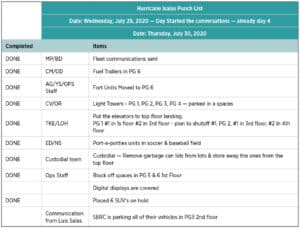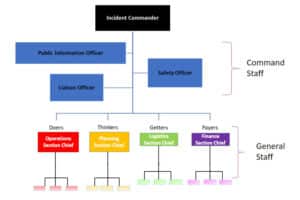
Address | Mitigate | Recover
Effective Emergency Preparedness
Address, Mitigate, Recover

Have you ever been in a situation where you thought you would need to respond to an emergency? Where something happened that required your immediate attention? Any situation that causes a strain to the masses or to the infrastructure of an area is considered an emergency. While many do not consider parking and transportation as an emergency support function, you must think of yourselves as a resource to the community in a time of need.
How does transportation function during an emergency, what is your role, and what support services can you provide? What impact will an emergency have on the community and how it will it disrupt continuing operations? Your answers will help you develop a response plan.
Table of Contents
Parking and transportation professionals can find themselves as a part of unforeseen events, testing our ability to react and take control of a situation while challenging our skills, knowledge, and capability to quickly respond. One of the key things any organization can do to ensure their team is safe and responsive to an emergency is to develop a plan. Not having a plan is planning to fail. Your best defense is a concise, well-organized emergency operations response plan.
Ask yourself: do you know “how” and “what” to do in the event of an emergency? How will you protect your team and your community? Do you know how to create a plan, and will you be ready to respond during an emergency? In this article, we will take you through how Florida International University (FIU) Parking & Transportation created a plan to help us successfully navigate through planned and predetermined emergency events.
Why are plans important? The development of an emergency preparedness plan, whether for a natural, structural, human caused, or operational disaster, is often the key to a quick response while mitigating human or structural loss. Having a plan creates confidence within the team and allows the team to perform better under a crisis.
We will cover how to develop the plan, train your team, and how to successfully execute. In addition, we will provide valuable resources to help you through your process.
Three steps for an Operational Plan

- Train the team. Identify training methods and tools such as Active Shooter Training and other training resources to help prepare your team.
- Execute the plan. Track your daily occurrences. Maintain notes. This helps your team stay updated.
It is essential that you have a well thought out plan. As we all know situations may change or issues will arise requiring you to adjust your plan. Starting with a solid plan is a great first step.
Developing the Plan
Once you have defined your essential areas of operation and your role in assisting your community in response to an emergency, you can begin gathering the information that will formulate the basis of your plan. A well-organized safety plan will take into consideration all potential forms of emergency, such as natural disasters, man-made or severe weather conditions including hurricanes, tornadoes, earthquakes, floods, blizzards, or mudslides. You should be familiar with the types of natural disasters that are likely to affect your region and preplan accordingly for these types of events.
Always know what to do before, during, and after a disaster. Assess your needs, do you have the equipment infrastructure in place to respond? If not, how do you quickly secure it. Identify your key stakeholders. Which partners do you need to help you navigate through the aftermath of an emergency? Use your operational plan to house the list of contacts and other valuable resources your team will need for a quick response to an emergency.
Creating a SWOT analysis of your department will help you establish the areas where you will be likely to succeed, but more importantly, will help you identify areas that you need to improve. The analysis will help you understand how you can best prepare to bridge the operational response gaps and identify improvement opportunities.
Identify your essential functions to ensure continuation of operations. Do you have the IT infrastructure in place and support staff to respond before, during, and after an emergency? Link your support to your needs. What’s the best way to assess availability? Survey your team and ask what support they can provide to the area should an emergency arise.
Proactive vs. Reactive
You identified your strengths and weakness using the SWOT analysis. Now is the time to implement solutions. A proactive approach yields better results than a reactive approach. How can you be more prepared to respond? Take all reasonable steps to prevent an emergency from occurring. Use technology such as a license plate recognition system which helps you identify who is parked on campus. Create a live integration with your parking permit software system for emergency targeted communications. Always be prepared to send out communications with standardized templates. These templates can be stored within your emergency response plan for easy access.
Leverage technology to make your plan effortless. A digital version of a plan makes it easy to disseminate and update seamlessly while maintaining the integrity of the document. You will need to consider that plans are a living document simply because situations will change, or new action items will come up requiring plan adjustments. We used digital channels to make the plan easily adjustable and accessible to our team members.
Lastly, understanding important elements such as data gathering, assessment, monitoring, and evaluating essential components before, during, and after an emergency is integral to the operations. This in an essential and meticulous task which can result in reimbursement being approved or denied. Create a punch list to help you track your team’s activity and task completion.
Below are additional resources and points which may be helpful in developing your plan:
- Follow established Incident Command System—it’s not just for Fire/EMS
- NIMS is an “all-hazards” program applicable to diverse incidents and developed by Homeland Security
- Think about your Management Structure
- Chain of Command
- Unity of Command
- Span of Control
- Accountability
- Resource Management
- Communications
- Internal
- External/Public/Media
Resources are available to you to assist with your plan development. Large scale emergencies are discussed in more detail in the FEMA app.
Training the Team
Having a plan creates confidence within the team and allows them to perform better during a crisis. Provide training to your team members and look for gaps in skillset. Everyone has specific skills they are very good at and identifying those strengths in a team is crucial to placing the right team members in the right role. Create scenario-based training focused on team response. Our FIU police have developed an eight-hour Active Training program. This program covers the points of run, hide, or fight. As mandatory training for over 10,000 faculty and staff members, the training not only directs how employees should respond and where to go should an emergency arise but places our officers in the exact scenarios they would encounter should they have to respond. Provide for Stop the Bleed, Defibrillator, and CPR training. FIU established bleeding control kits placed at strategic locations throughout campus made by our emergency operations team. We placed them on the first floor of every garage and every building on campus by the elevators. There are online training resources available. For additional information, visit training.fema.gov or ready.gov.
The more detail your employees you have the better. Be as specific as possible. Your team should be able to view all details within the emergency response playbook and will be able to link directly on each of the instructions and easily follow through. You will want to be as granular as possible. You do not want to assume someone your team knows everything you know—record it all. Keep track of your employees through remote clock-in software with attendance and task assignment tracking. Keep account of your material consumptions.
In addition, developing your team and finding other roles and processes which can be used in these emergencies reduces your struggle and cost, and should be clearly defined and communicated during training to address, mitigate, and recover should an emergency arise.
Be sure to invest in your staff development and enhancing their professional abilities. A well cross trained group will strengthen your response time.
Executing the Plan
There are planning resources available to you. We suggest you read them and identify what works best. Existing Emergency Action Plan are available:
- Local Police, Fire, EMS, Emergency Management Agency
- Websites (ready.gov, FEMA, DHS, OSHA)
Now that your plan is ready, how will you execute? Ensure you keep the plan up to date and provide preplanned training sessions for your team members to preview the plan guidelines and determine if there are any gaps or capabilities which still need to be addressed. Remember, responding to an emergency requires a trained, knowledgeable, and prepared team. Be sure to embrace other areas in your community which can support the response.
We have given you all the tools, including ideas and advice to help you structure an emergency operational plan. It’s up to you to make the difference – thank you and happy planning.
For more information on the information contained in this feature, email parking@fiu.edu to reach the FIU parking team.
Thomas Hartley, CAPP, is the Assistant Vice President of Operations & Safety for Florida International University.
-
This author does not have any more posts.
Brenda Dome is the Director of Parking & Transportation for Florida International University.
-
This author does not have any more posts.
Lissette Hernandez, CAPP, is the Director of Sustainability & Physical Plant for Florida International University.
-
This author does not have any more posts.


Miami Parking Authority Takes on Public Art Initiative
Nature Takes over the Walls of a Public Garage

Non-Criminal Adjudication of Parking Tickets
Why You Should be Adjudicating Your Own








